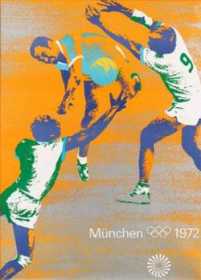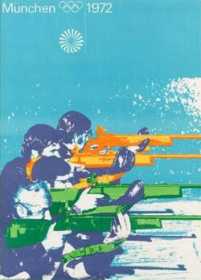Poster

| Design by: | Otl H. Aicher |
|---|---|
| Size: | 60 x 84 cm |
| Copies: | 5.000 |
| Comment: | 22 sport posters total 950.000 copies |
| The Posters 1972
Everywhere where people gather, posters attract attention for themselves and others. The opportunity to reach as many people as possible increases in places where there are crowds - this is the domain of posters. And since posters by their essence are also visual means of information about the Olympic Games, thus once again they are part of the overall image. While the Games as athletic events need no advertising - there are constant reports on them anyway - they do require public relations in order to be publicized as one would like them to be understood. A wide selection of posters for various posters was developed for the Olympic Games in Munich. Numerous posters were produced for special occasions (pre-Olympic-exhibitions, the torch relay, etc.) in addition to those for sports and cultural events. There were also posters with photos or just lettering; diagrams, maps or charts and tables were also given the character of posters. Quantitatively, the sports and cultural posters formed the focal point. They utilized different methods within the limits of the elements determining the image of the Games. The twenty-one sports posters were intended
to fulfill the following requirements: Thus a poster which must be legible in the
area of socialist realism or ancient cultural, technically underdeveloped
regions, should appear necessarily different than one whose validity is
restricted to western civilization. |

|

|

|
Under these conditions its message must be expressed in a language beyond verbal interpretations, i.e., in a picture language intelligible to the whole world. This basic conception was met by the tendency to favor photography of sports events as opposed to other forms of illustrations. Thus the goal of the Munich conception was to intensify the meaning of photography and its value as a signal for the purpose of information on the Olympic Games in Munich as expressed in form and color over and beyond the use of the emblem. Therefore, great care was taken to select typical athletic situations as photographic models. The abstraction and simplification of form and color were the means to this end. This process defined the symbolic character, allowed secondary features to vanish and kept the essential features. Most of all the strange colors, which took advantage of the signal value of color hues, caused scenes seen hundredfold and thus optically worn-out, to reappear as a call signal. Accustomed color associations were replaced by surprisingly new color values and combinations. |

|

|

|
Applied on either large areas or piecemeal they signified the typical atmosphere of each sport: the refreshing water, the expanse of the football field, the island of a fencing bout - despite every deviation from naturalistic depiction. The color tone was limited to the color spectrum of the Games for each sports poster and the theme color from this chart was assigned to each poster. The color combinations were constructed from only two to four more color tones in addition to the primary color. The sports posters became a part of a series for this reason alone. This characteristic was supported also by the left-to-right motion in every poster and by the horizontal lines. Another important feature of every sports poster is its form consisting of cut outs. Thus almost every figure and other elements were bled into the page. This principle suggests action and increases the signal value of the figures. Thus by means of concentration on typical aspects of each sport the posters became symbols which could be comprehended immediately by each viewer. The use of various posters together also increased the effect of the individual poster. Colors and signal effects mutually complemented each other. |

|

|

|
This series of posters did not promote the individual sports events, but rather the Games of the XXth Olympiad 1972 as a whole. As a result they had a representative function and were intended to accentuate the specific atmosphere of the Games. Thus two posters were developed within the course of the series according to the same principles. One suggested the architecture of the sports sites in Munich and the second hinted to Kiel where the yachting events took place. A definite, purely abstract system was true for the posters of the cultural events. For each one a basic color determined the color characteristics in connection with a colored band composed of colored stripes of different quantities and also evoked associations with the rainbow motif. General information - the cultural poster - provided the basic structure which, complemented by special data on individual events, constituted a verbal message in connection with an illustration. These very similar basic elements gave the posters the effect of belonging to a series, an effect also accentuated by the same height of the central lines in each poster. The purely text and photograph posters developed for the Games had a supplementary function in addition to these series. ( Source document: Official Report 1972, Vol. I, page 270) |